
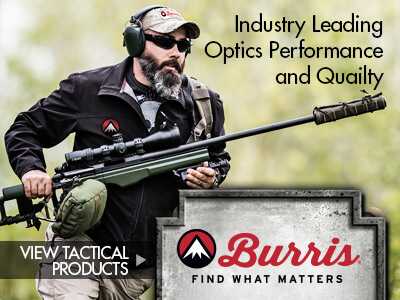
THE SERIES
- Part 1: Optics Buying Guide: Iron Sights, Red Dots, and Scopes
- Part 2: Optics Buying Guide: Top Must-Know Terms for Picking the Right Scope
- Part 3: Optics Buying Guide: Scope Mounts
- Part 4: Optics Buying Guide: How To Properly Zero Your Scope
- Part 5: Optics Buying Guide: Finding Your Range with a Scope Reticle
- Part 6: Optics Buying Guide: Hold Off vs. Adjustable Scope Turrets
- Part 7: Optics Buying Guide: Scope Reticles
- Part 8: Optics Buying Guide: Using a Laser Rangefinding Scope
- Part 9: Optics Buying Guide: Holographic and Red Dot Optics
- Part 10: Optics Buying Guide: AR-15 Optics and Scopes
- Part 11: Optics Buying Guide: Big Scopes
- Part 12: Optics Buying Guide: Do You Get What You Pay For?
When it comes to buying a scope, it can be easy to be completely overwhelmed by all the technical terms you see. So, what do you do? Maybe take a look at a glossary? Those are usually at the back of long books, and you never want to admit that you go there to learn some obscure word or terminology. We’ll try to handle this a little differently here and define important concepts in regular English. Besides, if you’re going to buy and use optics, then understanding these concepts is kinda important. I promise we’ll do our best to make it fun and interesting.
Here, we’ll try to cover the definition of various scope features and functions in such a way as to help you decide what features you need, and therefore what type of scope to choose, based on the type of shooting you do and the style of gun you have. For example, if your shooting world is all about fast targeting at short ranges, field of view will be a very important consideration. Will the size of a scope’s objective lens make a difference in your actual shooting performance? That depends. Read on and we’ll cover those types of issues.
Because last time we covered some of the basic issues with choosing a scope, we thought it good to go through all of the different specs you’ll find, and how they relate to performance and price.

Scopes may look straightforward on the outside, but there’s a lot going on inside.
Objective lenses and exit pupil
The objective lens is the (usually) larger opening at the front of a scope. There’s a partial myth about objective lenses that won’t ever seem to die. The belief is that the larger the objective, the more light that can be let in. Like most myths, there is some truth to that. The falsehood is that there is a limit. A six-foot diameter objective lens would certainly seem to let in a lot more light, but the problem is that your eye wouldn’t be able to take advantage of that. Besides, that would be really hard to mount on anything smaller than an M777 Howitzer.
Choosing the right optic for the job is a careful balancing act. After deciding on fixed or variable power, you have to match the other supporting design factors to make sure everything works together. To understand issues related to lens size and magnification, it’s easiest to start right at your eyeball. Your pupil is the limiting factor for the size of “light beam” that can enter your eye. In most situations, the perfect diameter of the beam of light coming out of the scope’s eyepiece is 5mm to 7mm. Knowing that, we can work backward to optimize the other features of the optic.
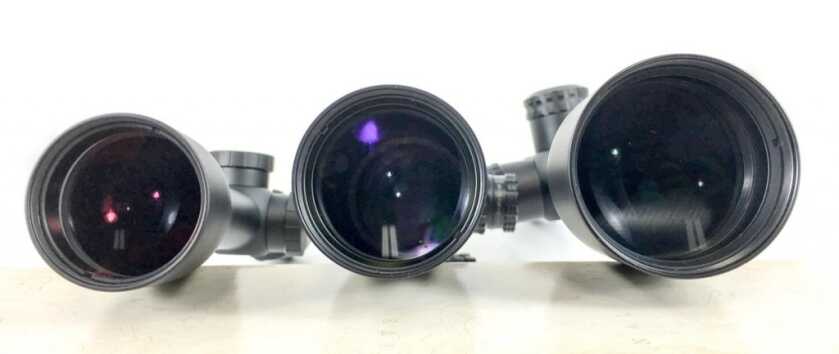
Think of exit pupil as the size of the cone of light coming out of the scope. It varies in size based on the size of the objective (front) lens and the level of magnification. Fortunately, the formula is easy. Just divide the objective diameter by the scope magnification level. So, a scope with a 40mm objective lens and 10x magnification has an exit pupil of 4mm. Crank the power down to 4x, and the exit pupil grows to 10mm. This is why a bigger objective lens is only better to a point. For our 10x scope, an imaginary objective lens of 100mm would yield an exit pupil of 10mm – more than our eye can see anyway, so there is no “extra light coming in” benefit to that huge objective lens. The larger light cone is there, but we can’t process it.
With all this said, larger magnification scopes will often have larger objective lenses, but bigger isn’t always better. To muddy the water even more, you also have to account for the quality of the glass. Imagine two scopes, identical to each other with the exception of objective lens size and glass quality. It’s entirely possible that the scope with the smaller objective lens, but better glass, will show you a brighter image than the one with a giant objective lens, but lesser quality glass.
We’ll get into this concept in more detail later in the series, but for now, just remember that objective lens size and magnification are a balancing act that has to be compatible with your eyeball.
Tube diameter
Larger tube diameters can be a good thing too. A 30mm scope tube can transmit more light, a little more clearly, than a one-inch (25mm) tube. Accordingly, a 34mm tube transmits more than a 30mm. All else the same, a larger tube can provide a brighter image that offers more clarity right to the edges of the viewable area.
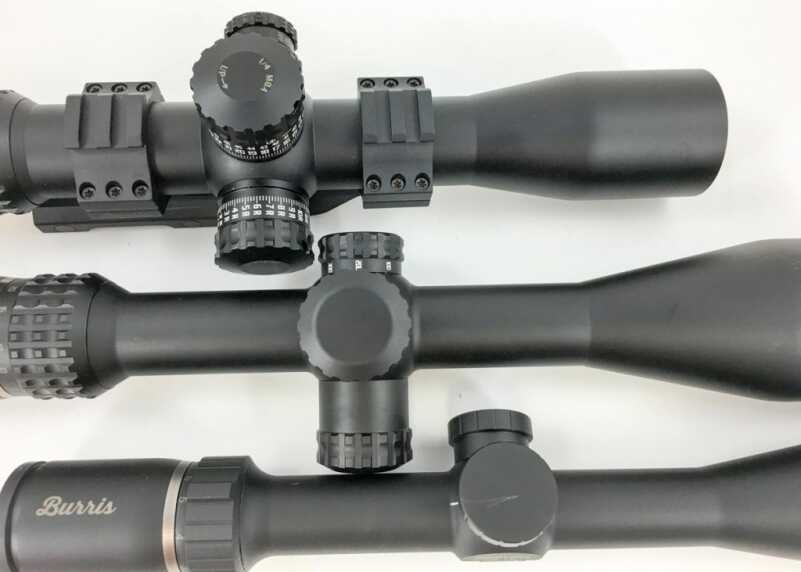
Three different scope tube sizes, bottom to top: one-inch, 30mm, and 34mm.
You’ll also note that larger tube diameters tend to go with larger caliber scopes. Here’s why. All the mechanics for adjusting for elevation are internal to the scope, so a larger diameter tube has more space for adjustment inside. The bottom line is that you can build in more “drop” adjustment that is required at longer ranges. I’ve shot scopes where there is not enough vertical adjustment capability to establish a proper point of aim on a distant target. This is one of the reasons for ramped scope mounts, but we’ll get into that later in the series.
Focal planes: first vs. second and what that means
Focal planes are one of the most complex topics in optics. Fortunately, the takeaways you need to know are pretty straightforward.
Let’s do the geeky part first. In a first focal plane scope, the reticle is physically placed towards the front of the scope tube, far in front of the magnification ring and lenses. This causes the reticle to grow and shrink as you change magnification settings. So, not only the image of your target will grow as you increase magnification, the size of the reticle will grow too. First focal plane optics are harder and more expensive to manufacture, so you’ll pay extra. On the plus side, since the reticle and target remain proportional, functions like range estimation and bullet drop compensation work at any power setting.
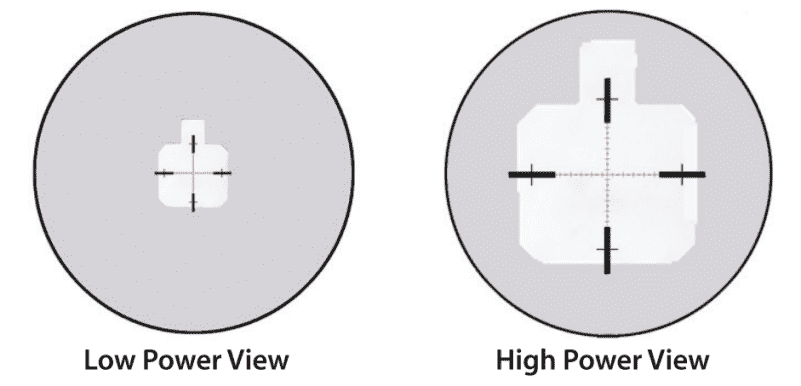
With a first focal plane scope, the reticle grows and shrinks with the target as you change magnification.
On a second focal plane scope (the vast majority of current rifle optics) the reticle is right next to the magnification ring. As you increase and decrease power level, the reticle always stays the same size. The benefits are that you can have a finer and more precise reticle design. The drawbacks are that range estimation and holdover marks are only valid at a designated power setting, usually full magnification.
If the topic is still a little murky, never fear. We’re going to get really deep into this when we talk about determining range, holdovers, and reticle types.
Coated lenses
Counterintuitively, coating a lens with a metallic fluoride or similar material allows more light to pass through than a perfectly clear glass lens. That’s because glass reflects light, bouncing it off in unproductive directions. Now consider that scopes have multiple lenses inside. If each one “loses” some light transmission due to reflection, you’re going to see a much dimmer image by the time it gets to your eye.
The coating simply serves to prevent all this random bouncing of light rays, allowing more of it to pass through the coated lens. Of course, quality of the coating process is everything, and you generally get what you pay for.
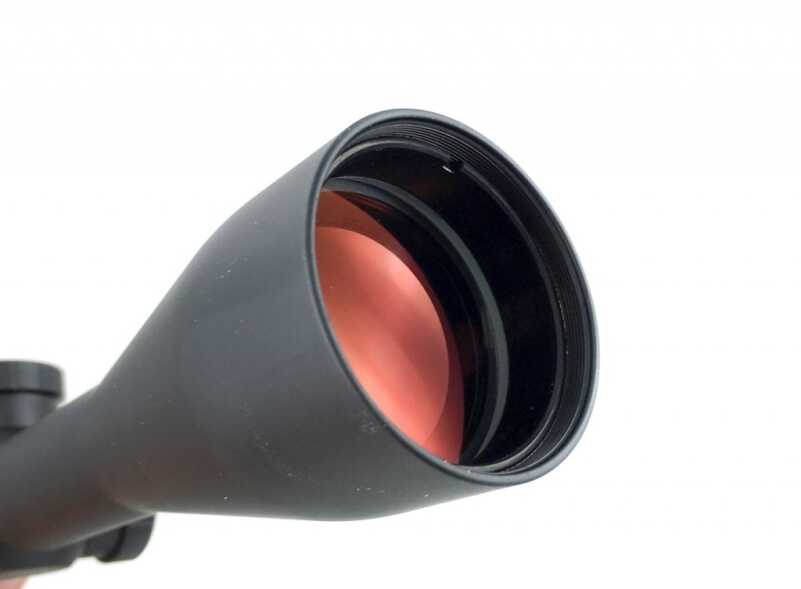
While counterintuitive, that colored coating you see on lenses allows more light pass through.
You’ll see scope manufacturers talk about multiple coatings, and this is generally a good thing. The process is mystical and expensive, but a multi-coated lens generally allows more light to pass through unimpeded than one with a single coating.
Turrets
When I hear the word turrets, I always think of tanks and castles. On scopes, the turrets stick out the top and sides of the scope body and house the adjustment dials for windage, elevation, and sometimes parallax and reticle illumination.
For windage and elevation turrets, you’ll encounter two basic styles, and each is appropriate for different shooting scenarios.
The “traditional” style of turrets are covered with protective caps. To make adjustments to elevation (up/down) and windage (left/right), the user unscrews the turret caps and turns the underlying dial as needed. When the setting is correct, the caps are returned, so the adjustments don’t get knocked out of place. The purpose of this style is really for “zeroing” the scope as needed. When preparing to take a shot in the field, it’s not realistic to be removing caps, making adjustments, and reinstalling them. You’ll often find this style of turrets on scopes with reticles that have hash marks for varying distances.
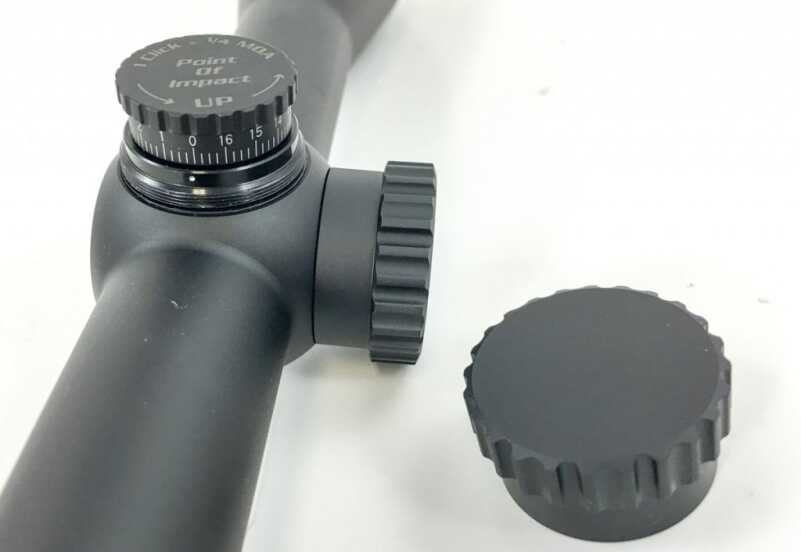
This Burris Fullfield II scope uses traditional covered turrets. However, when you remove the caps, they are hand adjustable. Some require a tool or screwdriver.
Target turrets expose the adjustments all the time. While there may be some rudimentary locking mechanism, the idea with target turrets is that you adjust in the field, for each shot at different ranges as needed. The turrets will have numerical indicators right on the outside that show the current adjustment setting for windage and elevation.
While there are a million “it depends” factors, if you’re a hunter, or need to take rapid shots at varying distances, the covered turret approach combined with a ballistic drop reticle is probably the way to go. If your scenarios allow for time and planning shot to shot, you may want exposed target turrets.

The target (or tactical) turrets on this Burris XTR II are exposed for rapid adjustment before a shot. The ratchet mechanism is solid so settings won’t get changed inadvertently.
Ballistic drop compensation reticles
While we’re on the topic of turrets, we ought to touch on the Yin of turret Yang. If the turrets are designed primarily for initial zeroing and occasional adjustment, you’ll need a way to aim at targets of varying range. A ballistic drop compensating reticle has marks that indicate hold points at different ranges. Some optics are etched for the trajectories of specific cartridges, like .223 Remington or .308 Winchester and have yardage indicators right on the reticle. If you’re 300 yards away, just hold on the 300 reticle mark.
Other reticles use general purpose markings like minutes of angle or milliradians. That’s a big topic on its own, so we’ll get into that in a separate article.
Practical application!
OK, so we’ve hit on some of the key “features” of optics. Now, what do you do with that information? The most important takeaway is the understanding a handful of key optics concepts so you can make a more informed choice about the type of scope that’s right for you. For example…
If you hunt in “average” scenarios meaning ranges of less than 150 yards or so, features like low magnification and wide field of view will be at the top of the list. Having 14x of magnification really doesn’t have a practical benefit in this type of situation and the limited field of view makes it hard to find and acquire your targets.
If your common shooting scenarios include getting shots off quickly, consider scopes with graduated reticles. Whether they have standardized hash marks like minutes of angle or milliradians or indicators for specific caliber ballistic compensation, these types of reticles allow you to adjust quickly for different ranges by simply holding over.
If your game is long range shooting, whether in a hunting or slow-paced competitive environment, consider target turrets. With adequate time to set up a shot, there’s a precision benefit to adjusting your scope to the perfect elevation setting.
Maybe you’re a three-gunner. Consider a low magnification scope that goes all the way down to 1x paired with a first focal plane reticle. The zero magnification setting, with the reduced reticle, will act much like a red dot optic. That offers speed and wide field of view. For 300 yard targets, crank up the magnification to five or six power, and now you have a graduated reticle for precise shots at that range.
Do you have a need to determine the range to the target using your scope? First focal plane optics shine for these situations. Regardless of magnification level, you can use the marks on the reticle to calculate the range to your target using some simple math. We’ll get into exactly how to do that later in the series.
In summary, it’s important to think through your anticipated shooting scenarios first. Then, you can start to apply some of these concepts to the selection of your ideal scope.

I AM the novice among you and also a communications professor. You did a fine job on this article. My thanks!
Although rather basic, this is a good article. Especially for the Novice among Us.
Indeed. A terrific article. Concise and clear. Thanks.
This is a fantastic article! Thanks very much; I learned a lot.
I believe light transmission is a function of the object of diameter and the glass composition itself. It has nothing to do with the diameter of the open tube in which light travels. How sure are you sure about the following statement?
“Larger tube diameters can be a good thing too. A 30mm scope tube can transmit more light, a little more clearly, than a one-inch (25mm) tube. Accordingly, a 34mm tube transmits more than a 30mm. All else the same, a larger tube can provide a brighter image that offers more clarity right to the edges of the viewable area.”
Newsflash Genius……All Optical grade glass is composed of the EXACT SAME COMPONENTS….In the Glass World it,s called boroscillicate. You might recognize it as
Pyrex. In fact, most of it, regardless of which Vendor is using it, is manufactured by the same company. That Company is and has been in China for the last 40 years.